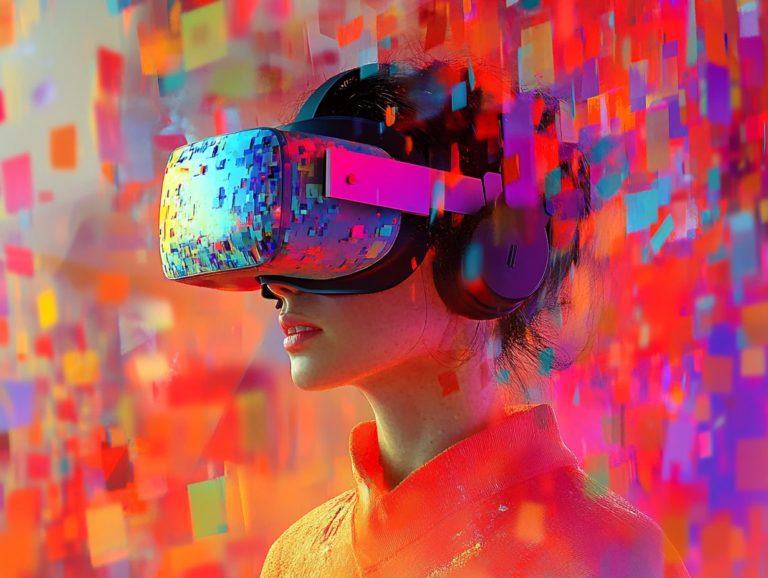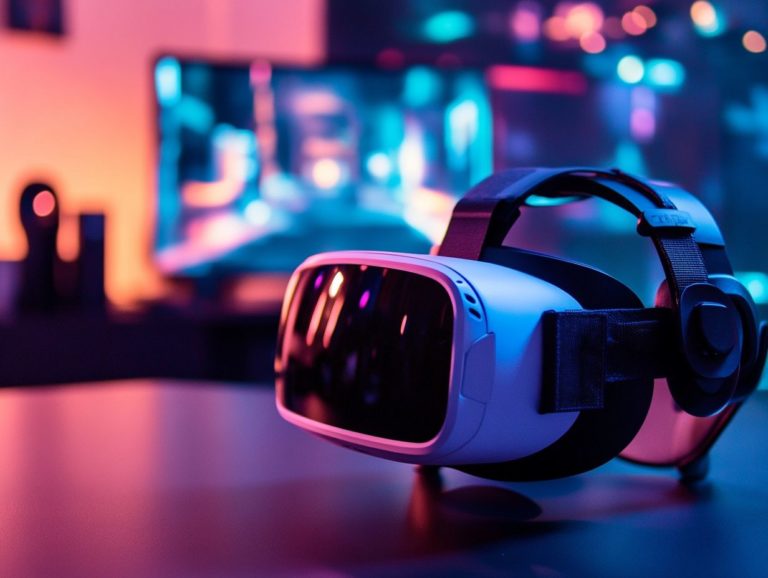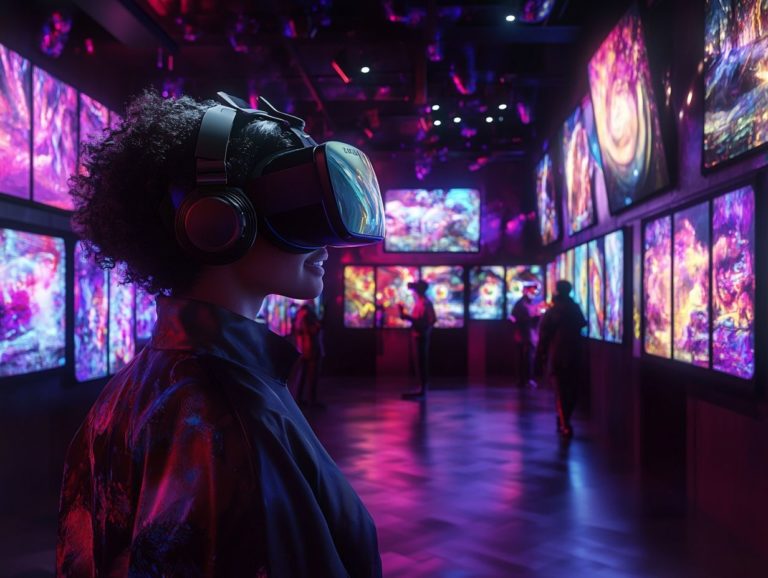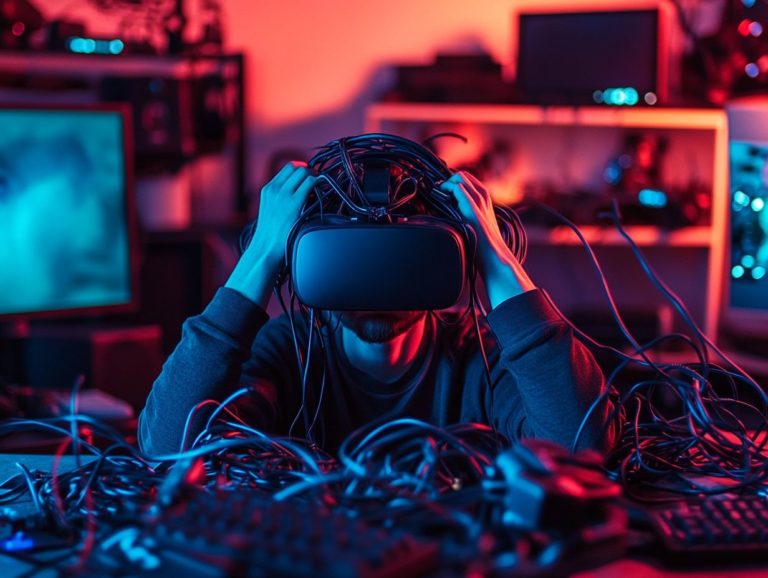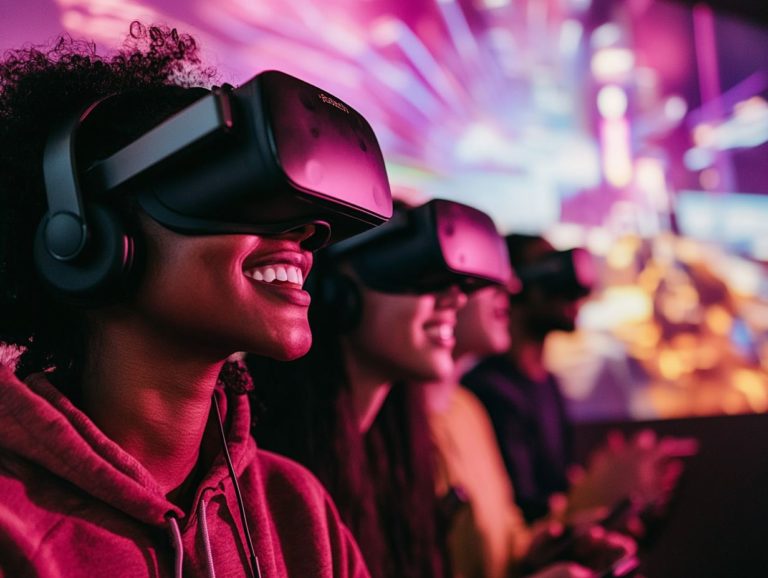how to choose the right vr headset for kids
Virtual reality (VR) headsets have emerged as an exciting way for children to explore immersive worlds, yet selecting the ideal one can feel overwhelming for parents.
With many options at your fingertips, it s crucial to evaluate important factors such as age appropriateness, comfort, and safety features to ensure a positive experience for your child.
This article details different types of VR headsets for kids, recommends the best options, and gives safety tips to empower you to make a well-informed decision.
Contents
- Key Takeaways:
- What is a VR Headset and How Does it Work?
- Factors to Consider When Choosing a VR Headset for Kids
- Types of VR Headsets for Kids
- Recommended VR Headsets for Kids
- Tips for Using VR Headsets Safely
- Frequently Asked Questions
- How do I know if a VR headset is suitable for my child?
- What features should I look for in a VR headset for kids?
- Are there any health concerns with using VR headsets for kids?
- Should I buy a standalone VR headset or one that requires a smartphone?
- What is the best VR headset for kids?
- How can I ensure my child’s safety while using a VR headset?
Key Takeaways:

Make sure the VR headset is suitable for your child’s age!
Comfort and fit are important factors to ensure a positive VR experience for kids.
Look for safety features and set time limits for safe and responsible use of VR headsets for kids.
What is a VR Headset and How Does it Work?
A VR headset is a remarkable device that lets you enter a virtual world, opening up an interactive gateway to many experiences, from exciting gaming to enlightening educational applications.
It operates with high-resolution displays and sophisticated user interfaces, creating a three-dimensional environment that invites you to explore virtual worlds and engage with content in real-time. This transforms the way you experience both entertainment and learning.
This technology combines motion tracking, 3D images, and spatial audio to elevate the realism and engagement of your adventures.
Take the Meta Quest 2, for instance it’s designed for remarkable portability and comfort, allowing you to enjoy extended sessions without discomfort. On the other hand, the Oculus Rift boasts extensive compatibility options, enabling you to connect with various devices and platforms, enriching the array of content available to you.
Whether you re diving into an adrenaline-pumping game or savoring a serene educational experience, these headsets offer a diverse range of interactions tailored to your preferences, immersing you deeper into your virtual journeys.
Factors to Consider When Choosing a VR Headset for Kids
Choosing the right VR headset for kids is crucial for their fun and safety!
It s essential to consider several critical factors to ensure a safe and engaging experience that aligns with their developmental needs.
Focus on the age appropriateness of the content available, the range of educational applications, and strong safety measures.
Look for features like parental controls and user-friendly interfaces that foster immersive learning while prioritizing security. Your careful attention to these aspects will help create a rewarding virtual experience for your child.
Age Appropriateness
Selecting age-appropriate VR content is essential for kids, as it guarantees that the experiences they engage with are not only entertaining but also beneficial for their cognitive development and learning.
Content libraries tailored for children often include interactive learning tools that stimulate both creative and critical thinking, positioning VR as an ideal medium for developing minds.
When considering educational applications, age-appropriate VR experiences can unveil complex scientific concepts through captivating simulations. Imagine exploring the solar system or dissecting virtual frogs customized to align with a child’s understanding and curiosity.
For instance, younger kids thrive in vibrant, simple environments that teach foundational math or language skills, while older children can dive into intricate problem-solving tasks designed to sharpen their analytical abilities.
Such thoughtfully crafted content captures their interest and ensures they face challenges that are just right for them, nurturing a passion for learning and reinforcing essential skills crucial at various developmental stages.
Comfort and Fit
The comfort and fit of a VR headset are essential, especially for kids who might be more sensitive to discomfort during longer sessions. A thoughtfully designed headset, featuring a lightweight structure and adjustable straps, can significantly reduce eye strain. This means they can dive into immersive experiences without compromising on comfort.
Ultimately, this enhances their engagement in both VR gaming and educational content. Lightweight materials alleviate pressure on the head and neck, keeping kids focused and engaged instead of distracted by discomfort. Adjustable straps ensure a secure fit, allowing for a tailored experience that accommodates various head shapes and sizes. This personalization boosts comfort and minimizes the risk of eye strain, as a properly fitted headset aligns perfectly with their line of sight. Adding haptic feedback increases immersion, enabling users to feel a deeper connection to the virtual world, enriching their overall experience.
Content and Safety Features
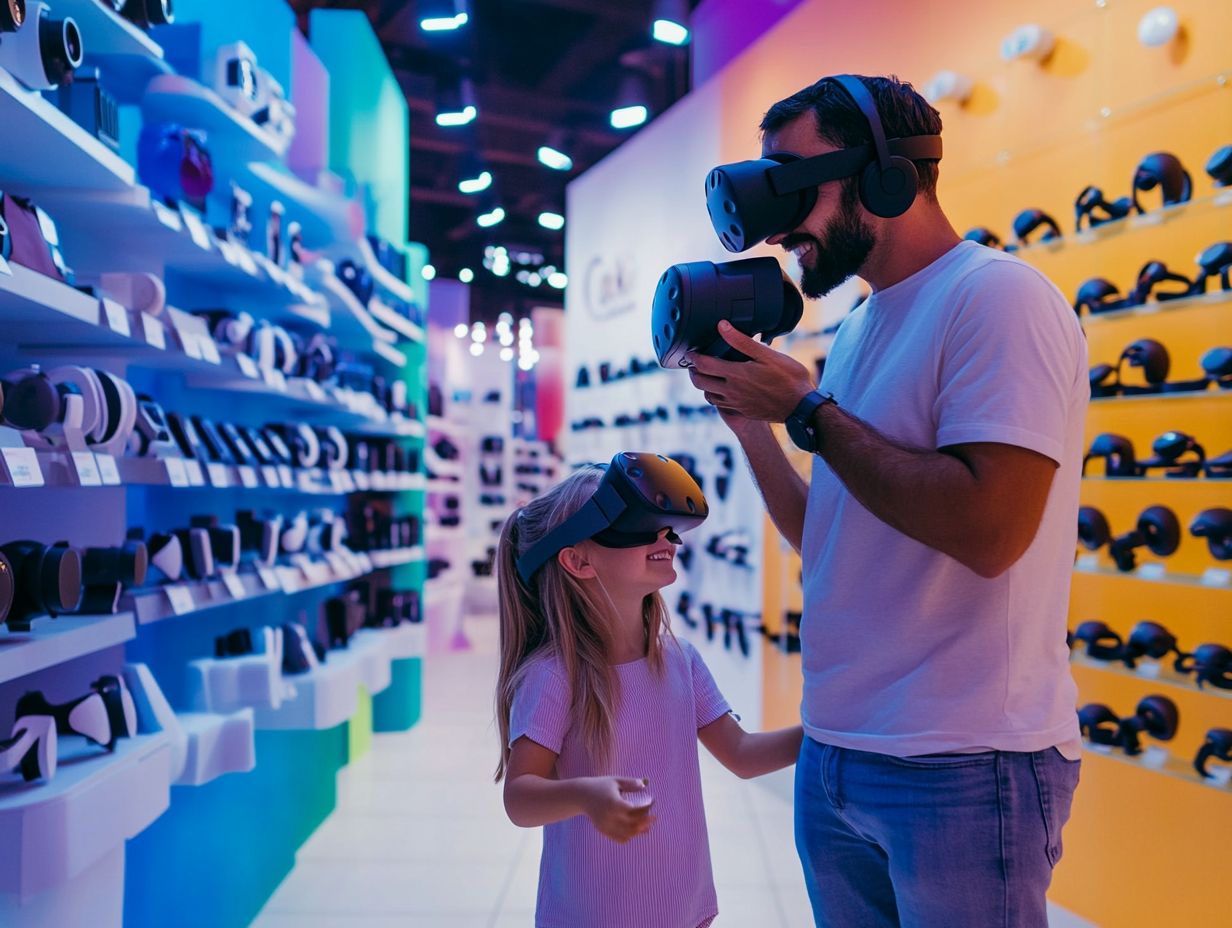
When creating content for kids, adding safety features is crucial for ensuring a secure and enriching VR experience. Headsets should come equipped with parental controls and strong safety rules, empowering children to explore a wide range of educational content while minimizing exposure to inappropriate materials.
This smart design sparks curiosity and deepens understanding of complex subjects. By providing interactive lessons that span science, history, art, and literature, kids can engage in hands-on learning that traditional methods simply can’t match.
With robust parental controls in place, you can curate their experiences, ensuring that their explorations remain safe and age-appropriate. These strategies create an exciting learning adventure that seamlessly blends fun with educational value, paving the way for a generation of informed and empowered young minds.
Types of VR Headsets for Kids
You’ll find a range of VR headsets designed specifically for kids, each tailored to meet diverse needs and preferences, whether you’re considering standalone devices or smartphone-compatible models.
It’s crucial for you to grasp the differences between standalone VR headsets, smartphone VR headsets, and PC VR headsets. This understanding will empower you to select the most engaging and suitable VR experiences for your children.
Standalone VR Headsets
Standalone VR headsets like the Meta Quest 2 deliver a seamless all-in-one experience for you and your kids, blending wireless convenience with powerful, immersive adventures that don t need any external devices.
Designed with user-friendliness in mind, these headsets often include adjustable IPD settings and a comfortable fit, allowing for extended use without sacrificing enjoyment. The portability and absence of tangled wires allow young users to dive into virtual worlds without being tethered to a computer, enhancing both their gaming and educational experiences.
The Meta Quest 2 dazzles with stunning visuals and boasts an extensive library of games and applications, ensuring there’s always something fresh and exciting to discover. Setting it up is a breeze, making it accessible even for those who might not be particularly tech-savvy.
This simplicity paves the way for families to enjoy shared moments of adventure and creativity together no special skills or tech wizardry required.
Smartphone VR Headsets
Smartphone VR headsets offer a cost-effective gateway for children to step into the captivating realm of virtual reality. These headsets leverage mobile devices for truly immersive experiences and are compatible with a variety of smartphones. This presents an accessible option for families eager to introduce interactive learning and entertainment.
By tapping into the potential of these affordable devices, kids can explore mesmerizing virtual environments that significantly enhance their educational journeys. Whether diving into the history of ancient civilizations or embarking on a journey through the wonders of the universe, the engaging nature of VR ignites curiosity and nurtures creativity.
These headsets provide an exciting platform for gaming, allowing children to play in imaginative ways that promote teamwork and problem-solving skills. With the perfect blend of fun and education, smartphone VR headsets transform learning into a thrilling adventure!
PC VR Headsets
PC VR headsets offer superior graphics and performance, making them ideal for immersive gaming experiences that engage kids. These headsets come with high-resolution displays and require compatible gaming systems to deliver exceptional visual quality and real-time simulations.
With powerful graphics cards and fast processors, every detail is rendered with remarkable precision, creating lifelike environments that captivate users. Thanks to motion tracking and spatial audio technologies, interaction with surroundings feels incredibly natural and exhilarating!
To unlock the full potential of these headsets, consider investing in systems equipped with robust hardware specifications. This combination will ensure a seamless and responsive gameplay experience like no other.
Recommended VR Headsets for Kids
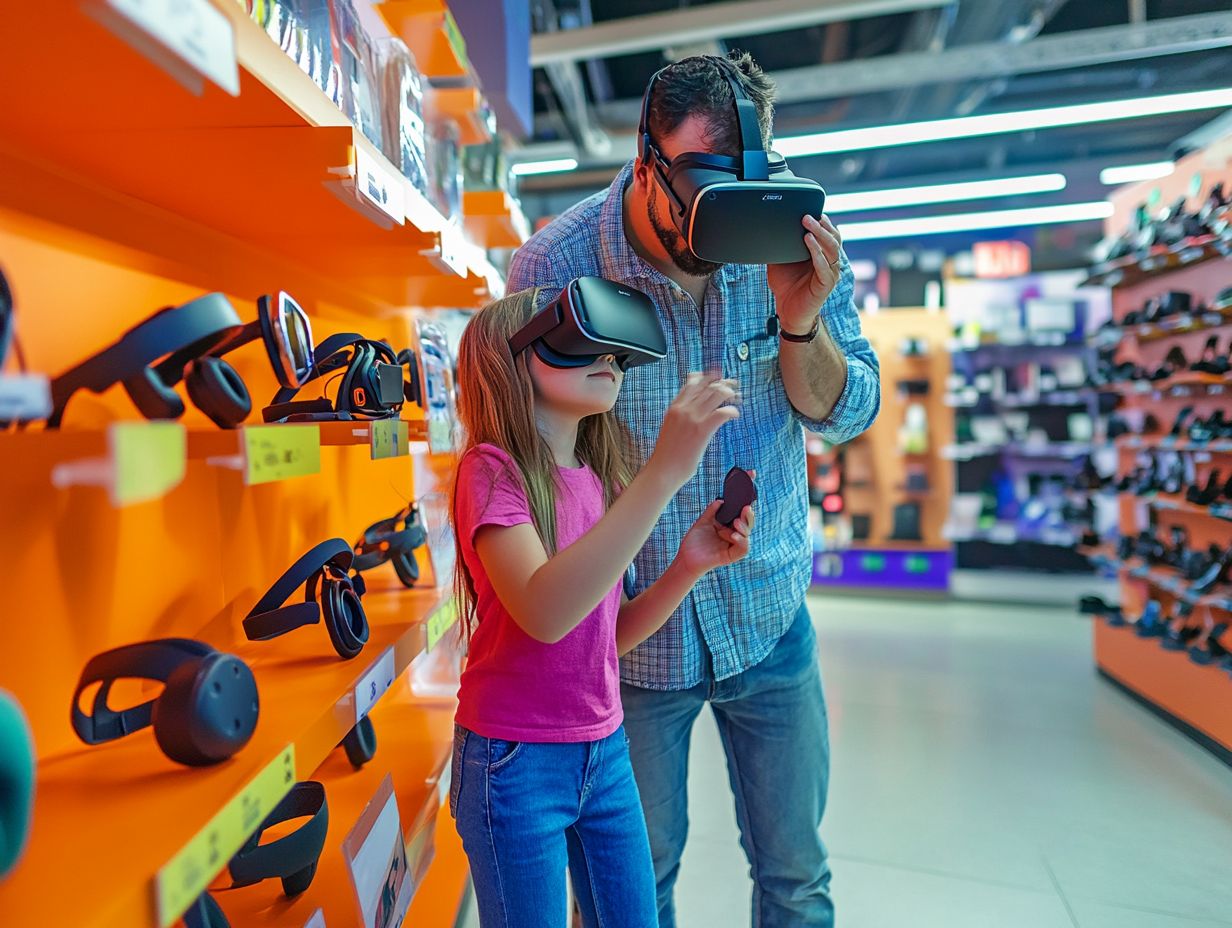
When searching for the best VR headsets for children, a curated selection awaits that caters to various age groups and preferences. This selection strikes a harmonious balance between entertainment and educational value.
Choosing the ideal headset involves evaluating age-appropriate features, ensuring comfort, and identifying immersive experiences that will captivate and enrich young users.
Top Picks for Different Age Groups
For various age groups, certain VR headsets emerge as standout choices that expertly blend immersive experiences with educational applications. These headsets are designed to offer safe and engaging avenues for kids to learn, play, and interact with virtual environments.
The Oculus Quest 2 particularly appeals to older children, thanks to its extensive library of educational content that includes immersive science and history adventures.
For younger users, the Lenovo Mirage Solo shines with its intuitive interface, supporting a diverse range of educational games that foster problem-solving and creativity.
Meanwhile, the Nintendo Labo VR Kit provides a uniquely imaginative experience, encouraging hands-on construction along with virtual interaction.
Each headset nurtures cognitive skills and sparks creativity, establishing them as invaluable tools for home and educational settings.
Tips for Using VR Headsets Safely
Ensuring the safe use of VR headsets for kids requires attention to key strategies that emphasize managing screen time, hygiene, and effective implementation of parental controls.
By adopting these practices, you can cultivate a secure environment that enhances the benefits of immersive experiences while mitigating potential risks associated with VR technology.
Start exploring the world of VR together with your kids today!
Setting Time Limits and Supervision
Setting appropriate screen time limits and ensuring proper supervision are essential steps in managing your kids’ VR experiences. This proactive approach helps prevent issues related to overuse and eye strain.
Set clear rules to keep immersive experiences enjoyable. Communicate the importance of taking breaks. Promote a balanced lifestyle that includes physical activity and social interactions.
Implementing technology usage schedules can help curb excessive screen time, framing it as a privilege rather than a right. Exploring parental control settings on devices enhances safety, allowing you to monitor content and usage duration.
Engaging in VR sessions together fosters shared experiences. It also opens up opportunities for conversation about healthy habits and the risks associated with virtual environments.
Proper Hygiene and Maintenance
Keeping VR headsets clean is super important, especially when kids share devices. It ensures a safe and fun experience for everyone!
Regular cleaning and inspection maintain the equipment and help prevent the spread of germs. This elevates the safety measures you should adopt as a parent.
To achieve this, it s essential to use the right cleaning solutions and materials that won t damage the lenses or fabric. Encourage your children to wipe down the headset before and after each use, paying special attention to areas that frequently come into contact with skin, like the face pads and straps.
Inspecting the hardware for any cracks or loose components boosts safety. Keeping the device stored in a dry, clean space protects its longevity.
By implementing these best practices, you and your family can create a hygienic environment that enhances the overall VR experience for young users.
Frequently Asked Questions
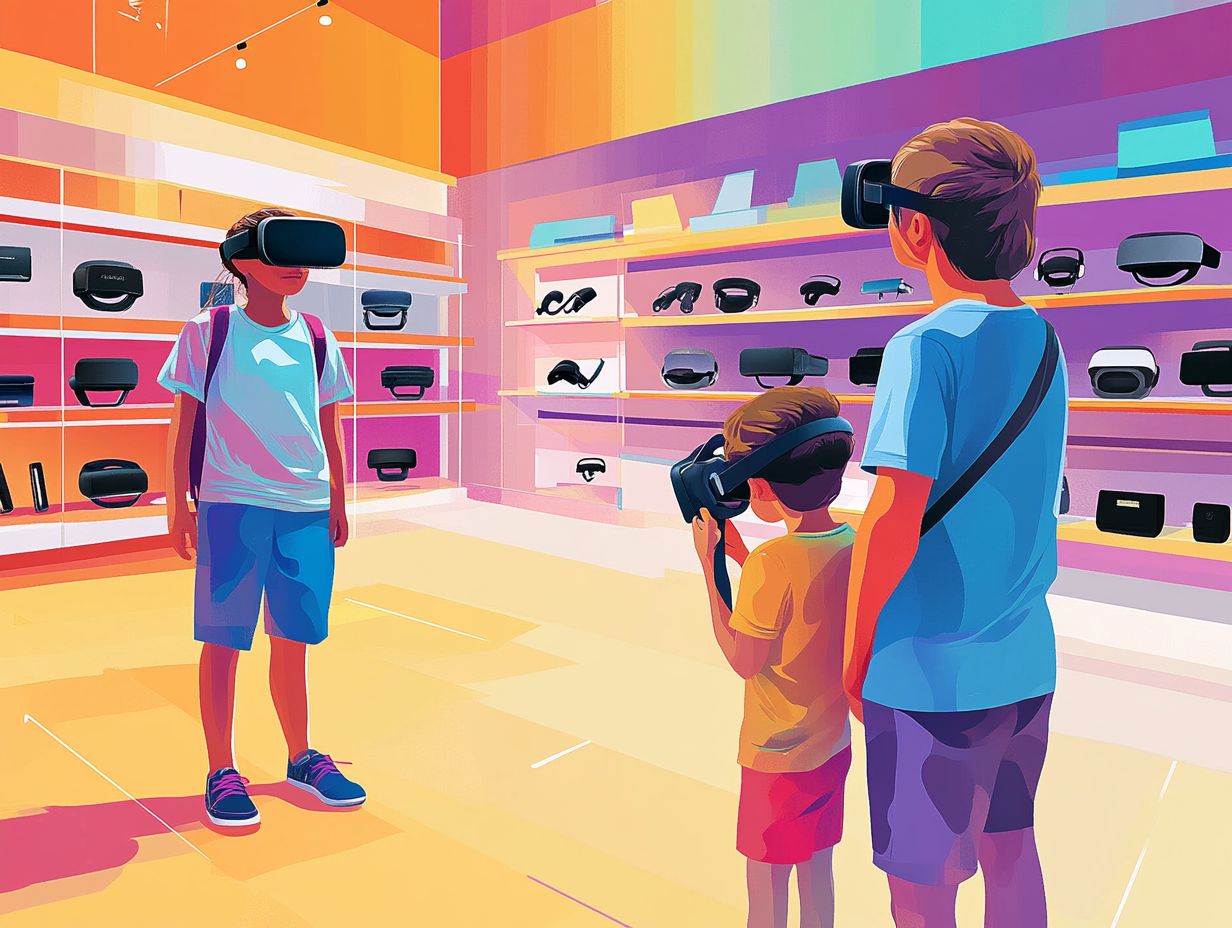
How do I know if a VR headset is suitable for my child?
When choosing a VR headset for kids, consider the age and size of your child. Most VR headsets have recommended age ranges and size limitations, so be sure to check these along with the key features to look for when buying VR gear before making a purchase.
What features should I look for in a VR headset for kids?
Some key features to look for in a VR headset for kids include adjustable straps and lenses, comfortable padding, and a durable build. These features will ensure a comfortable and safe experience for your child.
Are there any health concerns with using VR headsets for kids?
While VR headsets are generally safe for kids to use, there are some potential health concerns to be aware of. Extended use of VR headsets can cause eye strain and motion sickness, so it is important to limit usage and take breaks.
Should I buy a standalone VR headset or one that requires a smartphone?
Standalone VR headsets are typically more expensive, but they offer a more immersive and seamless experience. Headsets that require a smartphone can be a more budget-friendly option, but the quality may not be as high.
What is the best VR headset for kids?
There is no single best VR headset for kids, as it ultimately depends on the child’s age, size, and preferences. Some popular options include the Oculus Quest 2, Sony PlayStation VR, and Google Cardboard.
How can I ensure my child’s safety while using a VR headset?
To ensure your child’s safety while using a VR headset, supervise their usage and set time limits. It is also important to take breaks and ensure the headset fits properly and is adjusted to their comfort.

